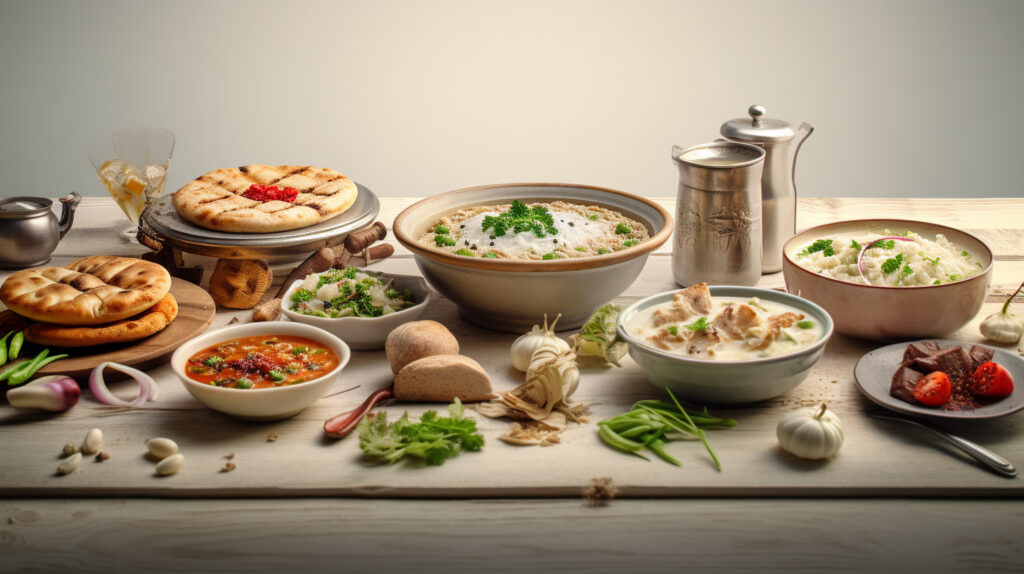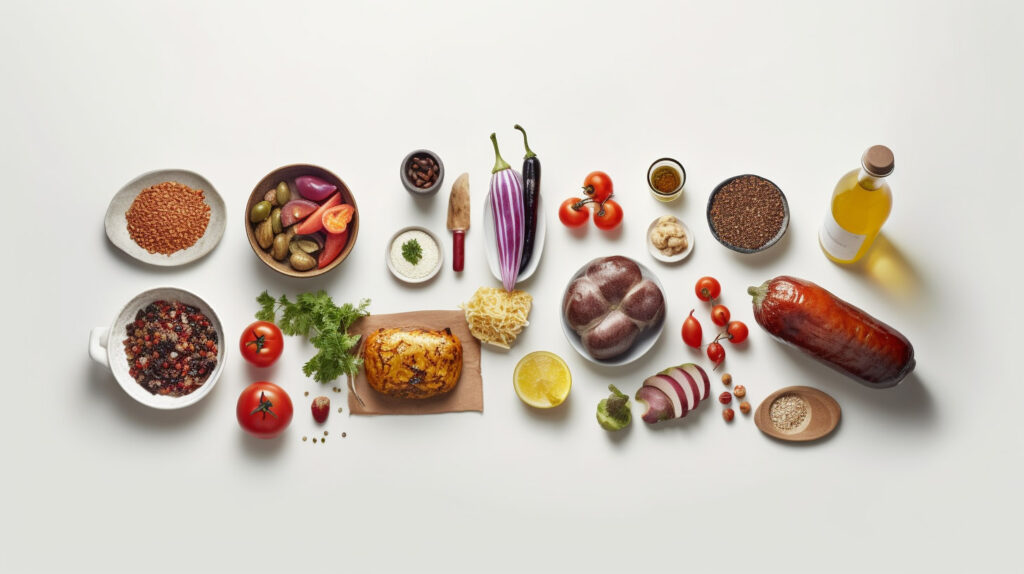Turkish Cuisine: Food Facts, Traditional Ingredients, Famous dishes, Recipes & More
Turkish cuisine is diverse, steeped in history, and admired worldwide for its unique blend of flavors and ingredients. In this article, we will delve into fascinating Turkish food facts across different categories.

Turkish Food Facts
General Facts
Fact 1: Influence of Many Cultures
Turkish cuisine is influenced by several cultures, including Greek, Persian, Arab, and Ottoman. It reflects the country’s position as a bridge between Europe and Asia.
Fact 2: Breakfast Culture
Turkish people take breakfast seriously. A traditional Turkish breakfast, or ‘kahvalti,’ often includes bread, olives, tomatoes, cucumbers, cheese, and eggs.
Fact 3: Meze Culture
Meze is a selection of small dishes served as a starter or as an accompaniment to alcoholic drinks. It’s a common dining practice in Turkey and emphasizes social and communal dining.
Fact 4: Use of Yogurt
Yogurt is a staple in Turkish cuisine, used in a variety of dishes, from meze and soups to sauces and desserts.
Fact 5: Importance of Bread
Bread is an integral part of almost every Turkish meal. The most common types are white bread and ‘simit,’ a circular bread typically encrusted with sesame seeds.
Fun Facts
Fact 6: Tea Consumption
Turkish people are among the top consumers of tea globally. Black tea is usually served in small, tulip-shaped glasses and consumed throughout the day.
Fact 7: Oldest Known Temple
Göbekli Tepe, in southeastern Turkey, is the site of the world’s oldest known temple. Archaeologists have found evidence of food preparation dating back over 11,000 years.
Fact 8: Doner Kebab’s Popularity
Doner kebab, thin slices of meat cooked on a rotating spit, is a popular fast-food dish in many parts of the world, originating from Turkey.
Fact 9: The Whirling Dervish Ceremony
The Mevlevi Order’s Whirling Dervish ceremony often involves a special meal. Participants fast for hours before the ceremony, then break their fast with a bowl of a thick, satisfying soup called ‘harira.’
Fact 10: Tradition of Sherbet
Sherbet, a sweet, non-alcoholic drink made from fruit or flower extracts, has been a part of Turkish culture for centuries. It was often served to guests as a sign of hospitality.

Nutritional Facts
Fact 11: Mediterranean Diet Influence
Turkish cuisine follows the principles of the Mediterranean diet, considered one of the world’s healthiest. It emphasizes fresh fruits, vegetables, whole grains, olive oil, and lean proteins.
Fact 12: Use of Legumes
Legumes, such as lentils, chickpeas, and white beans, play a crucial role in Turkish cuisine. They are a good source of protein and are often used in soups and stews.
Fact 13: High Fiber Content
Thanks to the liberal use of vegetables, legumes, and whole grains, traditional Turkish food is high in fiber, promoting digestive health.
Fact 14: Omega-3 Fatty Acids
Many Turkish dishes, especially those from coastal regions, contain fish, providing a healthy dose of Omega-3 fatty acids, beneficial for heart and brain health.
Fact 15: Limited Use of Processed Foods
Traditional Turkish cuisine uses limited processed foods, emphasizing fresh and locally sourced ingredients instead.
Traditional Dishes
Fact 16: National Dish
The unofficial national dish of Turkey is “kuru fasulye”, a white bean stew, typically served with rice and pickles.
Fact 17: Sultan’s Delight
“Hünkar Beğendi,” or Sultan’s Delight, is a traditional dish of lamb stew served over a creamy eggplant puree. It reportedly dates back to the Ottoman Empire.
Fact 18: Baklava
Baklava is a well-known Turkish dessert made of filo pastry, filled with chopped nuts and soaked in syrup or honey.
Fact 19: Meze Variety
The variety of meze in Turkey is astounding, with hundreds of dishes including hummus, dolma (stuffed grape leaves), cacık (a yogurt and cucumber dish), and many others.
Fact 20: Turkish Delight
Turkish delight, or ‘lokum,’ is a chewy, sweet confection often flavored with rosewater, lemon, or mastic, and sometimes filled with nuts.
Culinary Techniques
Fact 21: Cooking Techniques
Turkish cooking techniques are as diverse as the cuisine itself, including grilling, baking, frying, and slow-cooking.
Fact 22: Use of Spices
Spices are integral to Turkish cuisine, with cumin, paprika, mint, oregano, and red pepper flakes being particularly prevalent. These spices are used to create distinct, vibrant flavors.
Fact 23: The Art of Making Baklava
Making baklava is a delicate process involving thin layers of filo pastry, filled with nuts, usually pistachios or walnuts, and soaked in syrup or honey.
Fact 24: Traditional Tea Brewing
Turkish tea is traditionally brewed in a two-chamber pot called a “çaydanlık”. Water is boiled in the lower chamber and then used to steep the tea in the upper chamber.
Fact 25: Bread Baking
Turkish breads, from simit to pide, are traditionally baked in stone or brick ovens, giving them a distinct crust and flavor.
Influence on Global Cuisine
Fact 26: Doner Kebab’s Global Popularity
The doner kebab’s concept, involving seasoned meat cooked on a vertical rotisserie, has influenced similar dishes worldwide, such as the Greek gyro and the Middle Eastern shawarma.
Fact 27: Adoption of Baklava
Baklava, though Turkish in origin, has been adopted by many Middle Eastern and Balkan countries, each adding their own local twist to the sweet treat.
Fact 28: Turkish Coffee
Turkish coffee, known for its strong flavor and the way it is brewed and served, has been recognized by UNESCO as an intangible cultural heritage of Turkey. It has influenced coffee cultures worldwide.
Fact 29: Influence on Middle Eastern Cuisine
Many dishes that are common in Middle Eastern cuisine, such as kebabs, pilafs, and meze, have roots in Turkish cuisine.
Fact 30: Yogurt’s Global Influence
Yogurt, a staple in Turkish cuisine, has become popular worldwide, often marketed for its probiotic benefits and used in a variety of sweet and savory dishes.
Fact 31: Turkish Delight Export
Turkish delight, or lokum, has been a popular export product of Turkey for centuries. It has inspired similar confections in many countries around the globe.
Turkish Cuisine Main Ingredients

Olive Oil
Used extensively in Turkish cooking, olive oil is key to many dishes, especially in meze. It’s used for cooking, frying, and as a dressing in salads such as “Çoban Salatası.”
Lamb
Lamb is a favorite protein in Turkish cuisine. It’s used in a variety of dishes from kebabs like “Şiş Kebap” to slow-cooked stews and comforting dishes like “Hünkar Beğendi.”
Yogurt
Yogurt is a staple in Turkish cuisine. It’s enjoyed on its own, used in sauces like the garlic yogurt in “Mantı” (Turkish dumplings), and in soups such as “Yayla Çorbası” (yogurt soup).
Eggplant
Eggplant (aubergine) is commonly used in a variety of Turkish dishes. It’s the star in “Patlıcan Kebabı” (eggplant kebab) and “Patlıcan Salatası” (eggplant salad), and it’s also used in the famous “İmam Bayıldı.”
Red Lentils
Red lentils are often used in Turkish soups, the most famous being “Mercimek Çorbası,” a hearty red lentil soup. They’re also used in “Mercimek Köftesi,” a type of vegetarian meatball.
Tomatoes
Fresh tomatoes are integral to many Turkish dishes. They’re used in salads, stews, kebabs, and many egg dishes like “Menemen.”
Pul Biber (Red Pepper Flakes)
Pul biber, or red pepper flakes, is a common spice that adds a touch of heat to Turkish dishes. It’s used in many dishes like “Adana Kebab” and “Lahmacun.”
Sumac
Sumac is a spice that offers a tangy lemon flavor. It’s often sprinkled on top of “Çiğ Köfte” (raw meatballs) and used in salads like “Çoban Salatası.”
Bulgur
Bulgur is a type of cracked wheat that is commonly used in Turkish cuisine. It’s the main ingredient in “Pilav” (bulgur pilaf) and “Kısır” (a cold bulgur and vegetable salad).
Pomegranate Molasses
Pomegranate molasses is a syrup made from pomegranate juice. It provides a sweet and sour flavor to dishes. It’s commonly used in salads and as a topping for “Cig Kofte.”
Fresh Herbs
Fresh herbs such as mint, parsley, and dill are used generously in Turkish cooking. They’re used in salads, as garnish, and incorporated into dishes like “Mantı” and “Pide.”
Famous Traditional Dishes

Doner Kebab
Doner Kebab is one of the most famous Turkish foods, recognized worldwide. The dish features rotisserie-cooked meat, traditionally lamb but also chicken or beef, sliced thin and often served in bread with a variety of accompaniments. The name ‘doner’ comes from the Turkish word ‘dönmek’, which means ‘to rotate’, referring to the cooking process.
Baklava
Baklava is a sweet dessert made of layers of thin, flaky pastry filled with chopped nuts and sweetened with syrup or honey. While its exact origins are debated, it’s believed to have been perfected in the Ottoman palace kitchens and is now a signature Turkish dessert.
Meze
Meze refers to a selection of small dishes served before a main meal. Turkish meze can include a variety of dishes such as hummus, stuffed vine leaves, and “çerkez tavuğu” (Circassian chicken). The concept of meze has roots in the Ottoman Sultans’ elaborate feasts.
Manti
Manti are Turkish dumplings filled with ground lamb or beef, served topped with yogurt and melted butter, and often spiced with sumac and red pepper. The dish is believed to have been introduced to Turkey during the Mongol invasions of the 13th century.
Lahmacun
Lahmacun is a thin round flatbread topped with minced meat (most often beef or lamb), vegetables, herbs, and spices, then baked. It’s often referred to as ‘Turkish Pizza’. While its precise origins are unknown, it’s thought to have been influenced by the Armenian ‘lahmajoun’.
Pide
Pide is a boat-shaped flatbread baked with a variety of toppings, such as minced meat, spinach, cheese, and eggs. The dish is often considered a comfort food and has been a staple of Turkish cuisine for centuries, reflecting the country’s rich baking tradition.
Lokum (Turkish Delight)
Lokum, or Turkish delight, is a chewy, sweet confection often flavored with rosewater, lemon, or mastic, and sometimes filled with nuts. The sweet was created in the late 18th century by Bekir Effendi, a confectioner who opened a shop in Istanbul and whose descendants continue to sell Turkish delight today.
Simit
Simit is a circular bread, typically encrusted with sesame seeds. It’s often compared to a bagel and is a common street food in Turkey, traditionally enjoyed for breakfast with tea. The history of Simit dates back to the Ottoman Empire.
Hünkar Beğendi
Hünkar Beğendi is a traditional dish made of lamb stew served over a creamy eggplant puree. The dish dates back to the Ottoman Empire and its name translates to ‘The Sultan liked it’, suggesting its royal origins.
Dolma
Dolma refers to stuffed vegetables, often bell peppers, eggplants, or vine leaves, filled with a mixture of rice, ground meat, and spices. The name comes from the Turkish word ‘dolmak’ which means ‘to be stuffed’. This dish reflects the historical influence of Central Asia on Turkish cuisine.